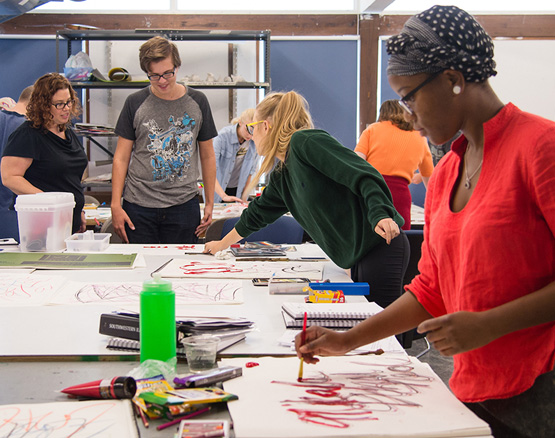Explore the World Through Art and Culture
Earning an Art History and Criticism Bachelor of Arts degree through ����Ӱҵ critically engages students with the arts of the past, present and future, developing a strong understanding of the values and concerns of people and the ways they interpreted and interacted with the world around them.
Our curriculum is uniquely woven alongside our Studio Art programs, allowing students to build a strong contemporary focus while studying how modern culture and historical groundwork influence art.

Our unique program is designed to emphasize the interdisciplinary nature of art and art history, allowing students to pursue interests in various disciplines. Our curriculum offers students opportunities to study:
- Early art and modern contemporary art
- Diverse studies in non-Western and ancient art
- The creation and materials used to create art throughout history
- Theory combined with practical experience through studio learning
- Up close to art history with Study Abroad opportunities
- Interdisciplinary areas of history, literature, philosophy and religious studies
Take Your Studies Beyond the Textbooks
Thesis and Symposium
The final project for the Art History and Criticism major is the senior thesis. A student chooses a paper written for an earlier ARHS course that they found of interest and want to develop the ideas further. Typically they work with the full-time faculty member for which they wrote that paper. The student applies in the Fall semester of the senior year to do the senior thesis in the Spring semester. During the Spring semester, they meet regularly with their thesis mentor, and periodically, with the senior thesis director and other students.
Art History and Criticism majors present their senior thesis to an audience during the annual Art History Symposium. The symposium is modeled on professional art history conferences, to provide students with an introduction to the practices of the career. Each student presents a 20-minute paper, and responds to questions from the audience.

Study Where Art Lives
����Ӱҵ provides Art History and Criticism degree students opportunities to take their studies abroad and delve deeper into their personal areas of focus. These unique opportunities allow students to pursue their interests while fulfilling program requirements.
The Department of Art, Design and Art History offers two alternating short-term Study Abroad trips to Italy; one to Venice for the , and the other to Florence to study Renaissance art. Additionally, Webster offers study abroad programs designed to fit different student schedules and needs, including Webster’s own global campus network locations, specialized summer Study Abroad programs, international partnerships and exchanges programs, and more.
In addition to our tailored opportunities, Webster’s faculty maintains relationships with many local, national and international professionals in their field. Students looking to pursue internships and careers will have access to a network of local professionals and opportunities to build relationships with local museums and galleries.
Transcript
Coming soon.
BA in Art History and Criticism
Find out more about the overall curriculum, electives, learning outcomes and more.
Get Started on Your BA in Art History and Criticism Degree
Take the next step toward earning your Art History and Criticism degree. We are here to answer your questions and help you get started.
Explore
Learn more about our academic programs and our main campus and locations.
Engage
Connect with our admissions counselors and academic advisors.
����Ӱҵ
and take the next steps for financial aid and scholarships.
Contact the Admissions Office to Find Out More
If you have more questions about the program, your application or other enrollment-related inquiries, contact our Admissions Office.
Call 314-246-7800 or 800-753-6765 or send an email to admit@webster.edu.

